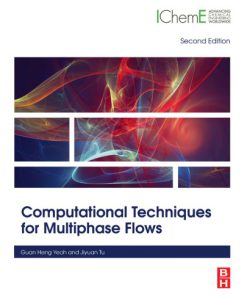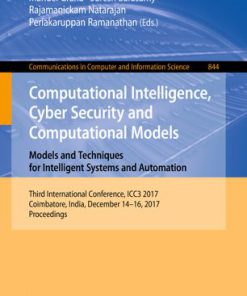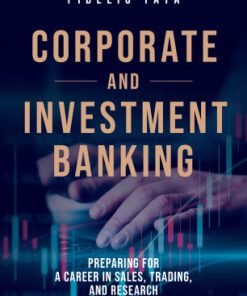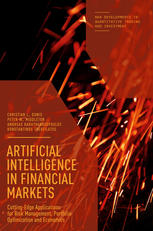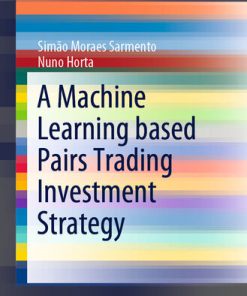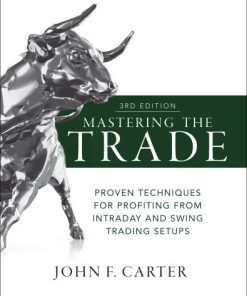Computational Intelligence Techniques for Trading and Investment 1st Edition by Christian Dunis, Spiros Likothanassis, Andreas Karathanasopoulos, Georgios Sermpinis, Konstantinos Theofilatos ISBN 0415636809 9780415636803
$50.00 Original price was: $50.00.$25.00Current price is: $25.00.
Computational Intelligence Techniques for Trading and Investment 1st Edition by Christian Dunis, Spiros Likothanassis, Andreas Karathanasopoulos, Georgios Sermpinis, Konstantinos Theofilatos – Ebook PDF Instant Download/Delivery: 0415636809, 9780415636803
Full download Computational Intelligence Techniques for Trading and Investment 1st Edition after payment

Product details:
ISBN 10: 0415636809
ISBN 13: 9780415636803
Author: Christian Dunis, Spiros Likothanassis, Andreas Karathanasopoulos, Georgios Sermpinis, Konstantinos Theofilatos
Computational intelligence, a sub-branch of artificial intelligence, is a field which draws on the natural world and adaptive mechanisms in order to study behaviour in changing complex environments. This book provides an interdisciplinary view of current technological advances and challenges concerning the application of computational intelligence techniques to financial time-series forecasting, trading and investment. The book is divided into five parts. The first part introduces the most important computational intelligence and financial trading concepts, while also presenting the most important methodologies from these different domains. The second part is devoted to the application of traditional computational intelligence techniques to the fields of financial forecasting and trading, and the third part explores the applications of artificial neural networks in these domains. The fourth part delves into novel evolutionary-based hybrid methodologies for trading and portfolio management, while the fifth part presents the applications of advanced computational intelligence modelling techniques in financial forecasting and trading. This volume will be useful for graduate and postgraduate students of finance, computational finance, financial engineering and computer science. Practitioners, traders and financial analysts will also benefit from this book.
Computational Intelligence Techniques for Trading and Investment 1st Table of contents:
Part I Introduction
1 Computational intelligence Recent advances, perspectives and open problems
1 Introduction
2 Artificial neural networks
2.1 Multilayer perceptrons
2.2 Recurrent neural networks
2.3 Higher-order neural networks
2.4 Radial basis function neural networks
2.5 Wavelet neural networks
3 Advanced CI classification/regression techniques
3.1 Support vector machines: support vector regression
3.2 Random forests
4 Heuristic methods
4.1 Classical deterministic methods
4.2 Meta-heuristic methods
5 Discussion
5.1 Overfitting
5.2 Feature selection: curse of dimensionality
5.3 Interpretability: performance tradeoff
5.4 Parameter tuning
6 Conclusions
References
2 Financial forecasting and trading strategies A survey
1 Technical analysis overview
1.1 Technical analysis vs fundamental analysis
1.2 Efficient market hypothesis and random walk theory
1.3 Profitability of technical analysis and criticism
2 Technical trading rules
2.1 The benchmark ‘buy-and-hold’ rule (BH)
2.2 Mechanical trading rules
2.3 Other trading rules
3 Automated trading strategies and systems
References
Part II Trading and investments with traditional computational intelligence techniques
3 Hidden Markov models Financial modelling and applications
1 Introduction
2 An introduction to Markov model and hidden Markov model theory
2.1 Markov models
2.2 Hidden Markov models
2.3 Financial modelling using hidden Markov models: properties and advantages
3 Computational implementation of hidden Markov models: calibration
3.1 Hamilton filter
3.2 Baum–Welch method
3.3 Advantages of the Baum–Welch method
4 Application of the Baum–Welch method and Hamilton filter to financial markets
4.1 Introduction
4.2 Equity markets application
4.3 Fixed-income markets application
5 Survey of current applications of hidden Markov models in finance
6 Concluding remarks
References
4 Adaptive filtering on forecasting financial derivatives indices
1 Introduction
2 Adaptive filtering in finance
3 Materials and methods
3.1 Datasets
3.2 Computational methods
4 Evaluation metrics, results and discussion
4.1 Evaluation metrics
4.2 Results and discussion
5 Conclusion
References
Part III Trading and investments with artificial neural networks
5 Modelling and trading the corn–ethanol crush spread with neural networks
1 Introduction
2 Literature review
2.1 Spread trading agricultural futures
2.2 Seasonality of agricultural futures
2.3 Application of neural network architectures
3 The corn–ethanol spread and related financial data
3.1 Statistical behaviour of commodity prices
3.2 Descriptive statistics
3.3 Rolling forward procedure
3.4 Discounting the existence of seasonality
4 Methodology
4.1 Benchmark models
4.2 Neural networks
5 Empirical results
5.1 Statistical performance
5.2 Trading performance
6 Concluding remarks
Notes
References
6 Trading decision support with historically consistent neural networks
1 Introduction
2 Historically consistent neural networks
3 Data
4 Trading strategy
5 Discussion
6 Conclusion
References
Part IV Trading and investments with hybrid evolutionary methodologies
7 Advanced short-term forecasting and trading deploying neural networks optimized with an adaptive evolutionary algorithm
1 Introduction
2 Related work
3 The examined financial indexes and related financial data
4 Forecasting models
4.1 Benchmark models
4.2 Proposed hybrid techniques
5 Empirical trading results
5.1 Transaction costs
5.2 Leverage to exploit high information ratios
6 Concluding remarks
References
8 Using argumentation and hybrid evolutionary multi-model partitioning algorithms for efficient portfolio construction
1 Introduction
2 Application domain and dataset description
2.1 The employed dataset
2.2 Evaluation criteria
3 Argumentation-based decision making
3.1 The argumentation framework
3.2 The decision maker’s argumentation theory
4 Forecasting the status of the financial market
5 The PORTRAIT tool
5.1 System architecture
5.2 System validation
6 Related work and discussion
7 Conclusion
References
Part V Trading and investments with advanced computational intelligence modelling techniques
9 Forecasting DAX 30 using support vector machines and VDAX
1 Introduction
2 Literature review
2.1 Support vector machines
2.2 VDAX
2.3 Technical analysis
3 Trading rule design
3.1 The data
3.2 The inputs
3.3 The SVM trading rule
3.4 The outputs
4 Results
5 Conclusions
Acknowledgement
Note
References
10 Ensemble learning of high-dimensional stock market data
1 Introduction
2 Related work
3 Background
3.1 Ensemble classification
3.2 Random forests
3.3 Markov blanket property
4 Markov blanket random forests
4.1 Determining the Bayesian network structure and the Markov blanket of the class node
5 Data and preprocessing
5.1 Sentiment analysis
6 Experimental results
6.1 Training time
7 Conclusions
People also search for Computational Intelligence Techniques for Trading and Investment 1st:
computational intelligence techniques
synergies of computational intelligence techniques
combating fake news with computational intelligence techniques
applications of computational intelligence techniques in communications
finite-element-model updating using computational intelligence techniques
Tags:
Christian Dunis,Spiros Likothanassis,Andreas Karathanasopoulos,Georgios Sermpinis,Konstantinos Theofilatos,Computational Intelligence,Techniques,Investment,
You may also like…
Business & Economics
Computers - Networking
Digital Communication Techniques 1st Edition Christian Gontrand
Uncategorized
Computers - Computer Science
Advanced Computational Intelligence Techniques for Virtual Reality in Healthcare Deepak Gupta
Computers - Computer Science
Computers
A Machine Learning based Pairs Trading Investment Strategy 1st Edition Simão Moraes Sarmento
Business & Economics
Mastering the trade proven techniques for profiting from intraday and swing trading setups Carter



